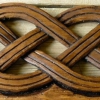Mallets! There's a big range to choose from.
In this lesson we look at their shape, what they are made from, sizes, weights etc and answer questions such as: 'What's the best weight to start with?' and, 'Do I need one of those funny little metal ones?' ...

| 17 December 2021 09:53
Reginald - There's a lot of personal preference here, besides the sheer physics of hitting something with a heavy object...
The 20oz is just the one I've found suits me best over the years but some carvers prefer heavier, others lighter weights. So, if you feel comfortable with your 16, go ahead.
In passing: I often hold this mallet more around the head and tap lighter, which in effect gives me a lighter mallet.

| 23 December 2019 18:17
Reginald - I don't know Pacific Yew but I would certainly try one in European Yew. Practically any dense hardwood will do. A popular wood for mallets has been Beech, that might be the one to compare it to - if you think it's as hard as Beech (or, say, Maple) then you'll be fine.

| 21 April 2012 14:20
Jack - There's no need to change if the square mallet works for you. In brief, the round surface allows you to hit a tool held to the work at almost almost any angle, with the mallet coming from all sorts of directions, without worrying about the stroke not being square on (as for a rectangular mallet) - the force comes as a tangent. Worth trying out? On the other hand, the square mallet is perfect for the accurate blows needed for mortises, for example.

| 17 April 2012 19:01
I use a normal rectangular carpenter's style mallet, which has been OK for me so far - what would be the benefit to me of getting a round carver's mallet?